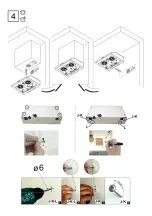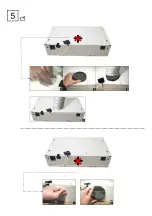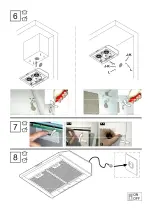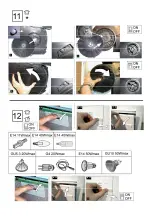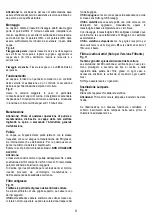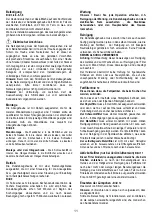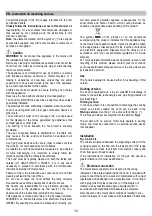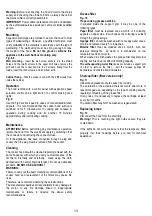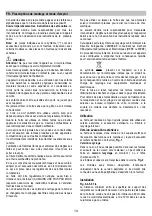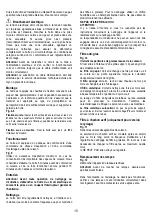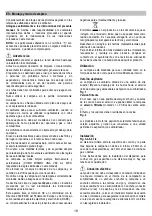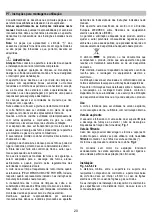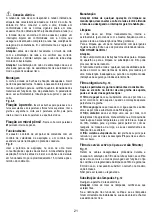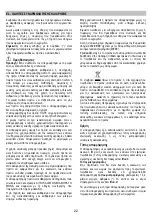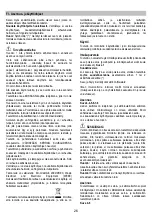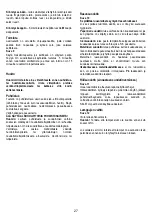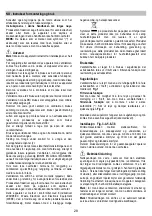
13
Warning:
Before re-connecting the hood circuit to the mains
supply and checking the efficient function, always check that
the mains cable is correctly assembled.
IMPORTANT!
Power cable replacement must be undertaken
by the authorized service assistance centre or similar qualified
person.
Mounting
Expansion wall plugs are provided to secure the hood to most
types of walls/ceilings. However, a qualified technician must
verify suitability of the materials in accordance with the type of
wall/ceiling. The wall/ceiling must be strong enough to take
the weight of the hood.
Do not tile, grout or silicone this
appliance to the wall. Surface mounting only.
Fig. 4-6
Wall mounting
- Insert the wall screw anchors
J
in the drilled
holes and the two
K
screws in the upper drill holes, remove the
grill and hook the cooker hood to the 2 screws, finally from the
inside, insert the third screw
L
and lock them all in.
Cabinet fixing
- Affix the cooker hood with the 4
M
screws from
inside the cabinet.
Operation
The hood is fitted with a control panel with aspiration speed
selection control and a light switch to control cooking area
lights.
Fig. 9
Use the high suction speed in cases of concentrated kitchen
vapours. It is recommended that the cooker hood suction is
switched on for 5 minutes prior to cooking and to leave in
operation during cooking and for another 15 minutes
approximately after terminating cooking.
Maintenance
ATTENTION!
Before performing any maintenance operation,
isolate the hood from the electrical supply by switching off at
the connector and removing the connector fuse.
Or if the appliance has been connected through a plug and
socket, then the plug must be removed from the socket.
Cleaning
The cooker hood should be cleaned regularly (at least with the
same frequency with which you carry out maintenance of the
fat filters) internally and externally. Clean using the cloth
dampened with neutral liquid detergent. Do not use abrasive
products.
DO NOT USE ALCOHOL!
WARNING:
Failure to carry out the basic cleaning recommendations of the
cooker hood and replacement of the filters may cause fire
risks.
Therefore, we recommend oserving these instructions.
The manufacturer declines all responsibility for any damage to
the motor or any fire damage linked to inappropriate
maintenance or failure to observe the above safety
recommendations.
Grease filter
Fig. 10
Traps cooking grease particles.
If situated inside the support grill, it may be one of the
following types:
Paper filter
must be replaced once a month or if colouring
appears on upper side, in such cases the colouring is evident
through the grill openings.
Sponge filter
should be washed with hot soapy water once a
month and replaced every 5 to 6 washes.
Metallic filter
must be cleaned once a month, with non
abrasive detergents, by hand or in dishwasher on low
temperature and short cycle.
When washed in a dishwasher, the grease filter may discolour
slightly, but this does not affect its filtering capacity.
The self-supporting metal filter
does not include a support grill,
in order to remove the filter – pull the release springs P4
backwards and slide the filter downwards.
Charcoal filter (filter version only)
Fig. 11
It absorbs unpleasant odours caused by cooking.
The saturation of the activated charcoal occurs after more or
less prolonged use, depending on the type of cooking and the
regularity of cleaning of the grease filter.
In any case it is necessary to replace the cartridge at least
every four mounths.
The carbon filter may NOT be washed or regenerated.
Replacing lamps
Fig. 12
Disconnect the hood from the electricity.
Warning!
Prior to touching the light bulbs ensure they are
cooled down.
If the lights do not work, make sure that the lamps are fitted
properly into their housings before you call for technical
assistance.



